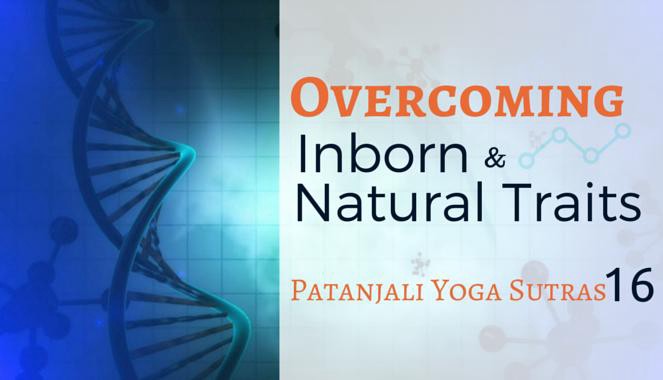तत्परं पुरुषख्यातेर्गुणवैतृष्ण्यम्॥१६॥
Tatparaṁ puruṣakhyāterguṇavaitṛṣṇyam||16||
The practice of detachment goes on to be so deeply established to overcome the natural guna a person is born with.
In this Sutra, Patanjali introduces a new term “Guna”, the literal translation of which is “quality” or “characteristic”. Let us look at what science has taught us about matter.
Electrons & Protons form atoms and atoms combine to form molecules and molecules make up the matter. Nanoscience is still trying to understand what constitutes protons and electrons. In Vedic science, Guna is to be understood as the inherent energy or characteristic that goes to form that matter. It includes both the physical form and the abstract form that is to be understood as a concept. We can understand Guna as a core energy which gives every matter its characteristic. As per Vedic science, matter is made up of three gunas, they are:
Sattva: Purity and Light,
Rajas: Action and Passion,
Tamas: Darkness and Inertia
These gunas are inbuilt into all matter, both living and nonliving. Our current topic being Yogic science, we are focusing on the gunas and their relation to thoughts. And as mentioned earlier in Sutra 2, yoga is the process of removal of vrittis (anomalies) of the chit (mind).
The three Gunas can also be understood as software, which brings matter (hardware) into existence and make them useful. At this juncture, it is important to understand that Gunas expound the relationship between matter and the energy form that is not visible but exists. Here, we are studying gunas in relation to the human body. Mind as a part and human body as a whole is made up of matter and blended with energy form known as Gunas. They are natural that come by birth and also imbibed in everyday life.
This may sound abstract and we will take an example to better understand the same. An Art student is given an assignment to make a model of Superman with a pound of clay. Now, the thoughts about the finished model that he wants to make are manifested in his mind. This is a Sattva thought, which has been imbibed by looking at videos about Superman; a Hero who wears his undergarment over his costume.
Now, there are thoughts associated with obstacles in completing that assignment, such as, the clay is not of good quality, the color is not the exact blue, it is a slow and painful task, etc. All these thoughts are Tamas thoughts. Further, with will power and skills, the student deftly molds the clay, gives it shape and puts in efforts to make the model; these are Rajas thoughts. All the three thought forms or gunas keep flowing together. That Guna, which is stronger in a person, creates the same state of mind.
In the above example, there may be various outcomes of the efforts put forth by the student to complete the assignment. The model of superman may turn out to be perfectly shaped, or grotesque or incomplete, etc. As students of Yoga, the point for us is to understand that all the three gunas or basic energy traits are seamlessly intertwined. There is a balance between them. One guna keeps dominating the other gunas, which results in different moods, thoughts, and actions. They work together in tandem against each other as well as with each other at the same time. This is the concept of Guna.
Excess of any one Guna is not good. Excess of Rajas Guna leads to aggressive and violent nature. Excess of Sattva leads to isolation and abstract thoughts, making a person indifferent, weird and lonely. Whereas, excessive Tamas guna leads to laziness, inaction and ignorance. It takes a balanced combination of all the three gunas to successfully lead the earthly life, earn money and eat food, interact with fellow human beings and live a purposeful life of happiness and bliss.
Coming to the Sutra, a person can overcome the gunas through practicing detached attachments. He can gain control over his persona and attain mental peace by creating balance between the gunas within him.
Through the practice of detached attachments, a yoga practitioner will be able to unlearn the wrong learnings. He will also be able to remove or balance the excessive gunas that he has been born with. Yoga will help him modify even the gunas or basic energy forces that have accompanied him over his births and rebirths. In addition, nurture or nature is also a strong point of debate in modern science trying to understand human nature. In this Sutra, Patanjali explains that yogic lifestyle helps overcome even the very nature, that the person has been constructed with.
Explaining it further, say a lion is known to have ferocious nature. Similarly, a person who has inborn violence in him, can get rid of the same with the help of yoga. Using the 8 limbs of Yoga, to be explained in the further sutras, a person can exercise enough control over his senses and thought waves. He can subdue or modify his nature instead of having an overly Rajas nature of aggression. It can be counterbalanced by equal sattva and tamas gunas. To sum up, The two sutras 16 & 17 can be understood as below:
- Realize your nurtured and natural thought waves.
- Accept them as they are, without any negative feelings.
- Do not negate or ignore them and allow pile up for uncontrolled eruption.
- Generate opposite and stronger thought waves to balance the negative thoughts.
- Understand the transient nature of thought waves and attain detached attachment.
These above sutras explain the effective and practical Yogic way to gain control over the thoughts waves. Too much of Sattva thoughts leading to inaction, laziness, and indifference is not Yogic Bliss as is wrongly proposed by many. Balance with all types of gunas and maintaining equilibrium is the objective here.
These Sutras are pretty crucial in understanding Yoga and its process. Hope you are getting an idea and getting an understanding of the working of the thought waves.
Next we will see how to evaluate if we have gained control over thought waves as mentioned above and continue monitoring ourselves as we improve.

